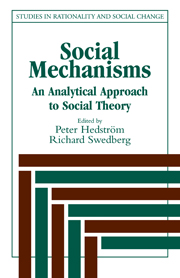Book contents
- Frontmatter
- Contents
- ACKNOWLEDGMENTS
- LIST OF CONTRIBUTORS
- 1 Social mechanisms: An introductory essay
- 2 Social mechanisms and social dynamics
- 3 A plea for mechanisms
- 4 Real virtuality
- 5 Concatenations of mechanisms
- 6 Do economists use social mechanisms to explain?
- 7 Social mechanisms of dissonance reduction
- 8 Social mechanisms without black boxes
- 9 Is sociological theory too grand for social mechanisms?
- 10 Theoretical mechanisms and the empirical study of social processes
- 11 Monopolistic competition as a mechanism: Corporations, universities, and nation-states in competitive fields
- 12 Rational imitation
- AUTHOR INDEX
- SUBJECT INDEX
3 - A plea for mechanisms
Published online by Cambridge University Press: 24 March 2010
- Frontmatter
- Contents
- ACKNOWLEDGMENTS
- LIST OF CONTRIBUTORS
- 1 Social mechanisms: An introductory essay
- 2 Social mechanisms and social dynamics
- 3 A plea for mechanisms
- 4 Real virtuality
- 5 Concatenations of mechanisms
- 6 Do economists use social mechanisms to explain?
- 7 Social mechanisms of dissonance reduction
- 8 Social mechanisms without black boxes
- 9 Is sociological theory too grand for social mechanisms?
- 10 Theoretical mechanisms and the empirical study of social processes
- 11 Monopolistic competition as a mechanism: Corporations, universities, and nation-states in competitive fields
- 12 Rational imitation
- AUTHOR INDEX
- SUBJECT INDEX
Summary
Introduction
Are there lawlike generalizations in the social sciences? If not, are we thrown back on mere description and narrative? In my opinion, the answer to both questions is No. The main task of this essay is to explain and illustrate the idea of a mechanism as intermediate between laws and descriptions. Roughly speaking, mechanisms are frequently occurring and easily recognizable causal patterns that are triggered under generally unknown conditions or with indeterminate consequences. They allow us to explain but not to predict. An example from George Vaillant gives a flavor of the idea: “Perhaps for every child who becomes alcoholic in response to an alcoholic environment, another eschews alcohol in response to the same environment” (Vaillant 1983, p. 65). Both reactions embody mechanisms: doing what your parents do and doing the opposite of what they do. We cannot tell ahead of time what will become of the child of an alcoholic, but if he or she turns out either a teetotaler or an alcoholic, we may suspect we know why.
Although the bulk of this essay concerns the use of mechanisms in the social sciences, the idea has wider application. In her claim that “the laws of physics lie,” Nancy Cartwright uses the following illustration:
Last year I planted camellias in my garden. I know that camellias like rich soil, so I planted them in composted manure. On the other hand, the manure was still warm, and I also know camellia roots cannot take high temperatures.
- Type
- Chapter
- Information
- Social MechanismsAn Analytical Approach to Social Theory, pp. 45 - 73Publisher: Cambridge University PressPrint publication year: 1998
- 199
- Cited by



